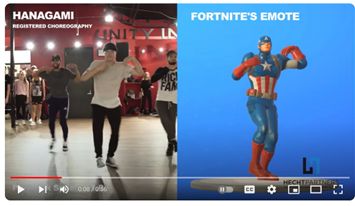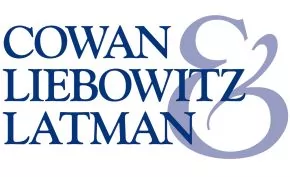The Copyright Act lists "choreographic works" as one of the eight types of creative works that are protectable under federal copyright law (17 U.S.C. Section 102(a)(4)). However, the Act itself does not define "choreographic works" and thus far, there has been surprisingly little case law discussing the scope of what can or cannot be protected. A recent Ninth Circuit case, Hanagami v. Epic Games, Inc., took a stab at addressing this question and ultimately provided some helpful guidance.
Background: Legislative History & Guidance from The Copyright Office
It is generally agreed that Congress did not intend for all types of dances or dance movements to be protected by copyright. The legislative history of the Copyright Act indicates that "choreographic works" have a "fairly settled meaning" in that they do not include "social dance steps and simple routines." H.R. Rep. No. 94-1476, at 53 (1976). But what differentiates protectable "choreography" from a "social dance" or "simple routine," and where is the line drawn between them?
In the Copyright Compendium, a publication produced by the Copyright Office and intended to provide guidance to those who wish to register for federal copyright protection1, the Copyright Office explains that "the dividing line between copyrightable choreography and a simple routine is a continuum, rather than a bright line. The U.S. Copyright Office may register complex dances consisting of a related series of dance steps, movements, and patterns organized into a coherent compositional whole." Copyright Compendium 805.5(B)(1). Inherent in the Copyright Office's definition of "choreography" is an understanding that while individual dance or choreographic movements by themselves generally will not qualify for copyright protections, an arrangement of those steps into a final "compositional whole" can have the requisite level of originality necessary for copyright protection.
Indeed, just as words, numbers, notes, colors, and shapes are not protectable by themselves, but can instead be used as building blocks for copyrightable expression, so too, "individual movements or dance steps by themselves are not copyrightable" while "choreographic works that incorporate social dance steps, simple routines, or even athletic exercises may be protected by copyright, provided that the work as a whole contains a sufficient amount of choreographic authorship." Copyright Compendium 805.5(A) and 804.5(D).
Hanagami v. Epic Games
The recently decided Hanagami v. Epic Games, Inc. raised these issues and gave courts a chance to "dance their way through" and make sense of the guidance from the Copyright Office.
At issue was a dispute between choreographer Kyle Hanagami, known for working with famous artists such as Jennifer Lopez, Britney Spears and Justin Bieber, and the videogame maker Epic Games, which had allegedly used portions of Hanagami's choreography in its game Fortnite. As part of the game, players could purchase "emotes" – virtual animations that could be used to make the player's avatar celebrate or dance in the game. Hanagami alleged that one such emote, a four-count series of movements that Epic called "It's Complicated," resembled one of Hanagami's dances to a Charlie Puth song, which was available on YouTube and had been viewed by millions. Hanagami registered the video with the Copyright office and sued Epic in the Central District Court of California.

See here for a comparison of the works at issue:
https://www.youtube.com/watch?v=vXYDr9o_FJY
The District Court's Decision
Despite the similarities between Hanagami's choreography and the Fortnite emote, the District Court granted Epic's motion to dismiss, reasoning that Hanagami failed to plausibly allege that the two works were "substantially similar."
Applying the "extrinsic test," whereby one must first identify and compare only the copyrightable elements of the works at issue for similarities, the District Court reasoned that the works' copyrightable elements were not substantially similar. While Hanagami appeared to be seeking protection over individual "poses" or "steps," these elements were unprotectable and therefore needed to be filtered out of the analysis. Once they had done so, the remaining protectable elements were not similar enough to the emote to be considered substantial under the District Court's analysis.
The District Court further reasoned that that the allegedly copied portion of Hanagami's routine was too small a component of the overall work (a few seconds of a 5-minute video) and that it was too short a work (a four-count series of eight steps) to be protectable. For those reasons, the case was dismissed.
Hanagami appealed to the Ninth Circuit.
The Ninth Circuit's Decision
Acknowledging that the field of choreography copyright was a largely undefined area, the Ninth Circuit took the opportunity to officially adopt the Copyright Compendium's definition of "choreography" and to explain how the "substantial similarity"2 test should be properly applied.
The Ninth Circuit found that the District Court had erred in applying the extrinsic test by reducing Hanagami's choreography to unprotectable poses. In doing so, the court failed to consider that there were original and protectable elements present in Hanagami's work. The Ninth Circuit explained that Hanagami's creative choices of "body position, body shape, body actions, transitions, use of space, timing, pauses, energy, canon, motif, contrast, and repetition" were all original and protected elements that should have been considered by the court and compared to the Fortnite emote. In properly applying the test, and considering these elements, the Ninth Circuit found that many of the creative choices regarding the movement of the body, and tempo were similar between the two works. As such, they found that Hanagami had plausibly alleged that the works were substantially similar.
In addition, the Ninth Circuit found that the District Court erred by ruling as a matter of law that short collections of dance steps are unprotectable just because they are brief. The Ninth circuit explained that while de minimis copying (copying just a small insignificant portion of a larger work) is not actionable, the mere length of the copied material should not be the only consideration in determining whether a work is protectable. The Ninth Circuit found that despite the shortness of the four-count dance used in Fortnite, Hanagami plausibly alleged that the portion had substantial qualitative significance to the overall registered choreographic work because it was repeated throughout and was used during the chorus and other significant parts of the song. As such, it was more than just a de minimis element.
The Ninth Circuit further explained that although Hanagami's work was made up of a series of steps, which normally would be considered an unprotectable "simple routine," this was not necessarily a given; some combinations of dance steps can be quite complex, and could merit copyright protection. Indeed, Hanagami's four-count steps were a fast-paced series of patterns and movements that involved the whole body and were performed by highly trained dancers. In the eyes of the Ninth Circuit, this made it plausible that they were more than just an unprotectable "simple routine."
Ultimately, the Ninth Circuit found that the District Court erred in its application of the substantial similarity test. Because Hanagami's work was plausibly substantially similar to the emote, dismissing the case was improper. The Ninth Circuit reversed and remanded the case back to the District Court for the court to reassess in light of the new factors that the Ninth Circuit discussed.
Takeaways
Although the court didn't introduce any bright line rules, the Ninth Circuit's ruling made clear that determining whether a portion of a choreographic work is protectable or not is a fact-specific question that requires an analysis of the actual dance steps used, an appreciation for the different types of creative choices made by the choreographer, and looking at what has been copied in the context of the full work.
Whatever may happen on remand, the Ninth Circuit's decision provides insight into the factors courts should consider when determining whether a work is protectable or not.
Footnotes
1. The Copyright Compendium can guide courts, but it is not officially binding on them.
2. Hanagami had argued to the Ninth Circuit that choreographic works should always be afforded "broad" copyright protection since choreographic works can be made up of a wide range of possible expressions and broad creative choices and that that the District Court had erroneously suggested the opposite, that choreographic works are only entitled to "thin" protection since there are only a narrow range of possible expressions and a limited range of creative choices available to choreographers. Under Ninth Circuit precedent, works afforded "broad" protected are analyzed under the "substantial similarity" test whereas infringement for "thinly" protected works can only be found if the works are "virtually identical". The Ninth Circuit explained that Hanagami had mischaracterized the District Court's position because even though the District Court may have suggested that protection for choreographic works is thin, the District Court used the "substantial similarity" test used for works afforded broad copyright protection instead. Accordingly, the Ninth Circuit chose not to decide on the question of whether thin or broad copyright protection should be afforded to Hanagami's claim or choreography more broadly. Instead, they took the opportunity to discuss the "substantial similarity" test used since that was the standard used by the District Court.
The content of this article is intended to provide a general guide to the subject matter. Specialist advice should be sought about your specific circumstances.

